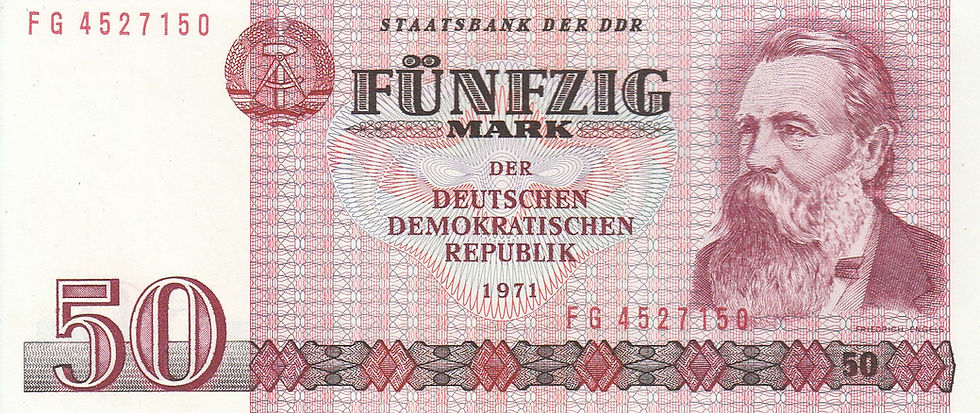Notes Of The DDR, Friedrich Engels: 50 Mark (East Germany, 1975)-Article
- smithwicknumismati
- Sep 22, 2021
- 3 min read
Updated: Apr 17, 2024
This small East German banknote represents the 4th denomination of DDR Mark (Series 1971/1975 M). The Series M replaced the previous 1964 Series MDN, at face value. These notes are narrower and longer than the previous 1964 Series. In addition to featuring different observe and reverse art. With the exception of the 5 and 10 Mark, they feature the same historical figures.
Notably the Series M served as the last banknote series of East Germany. Until the post-reunification adoption of the West German Deutsche Mark, on 1 July 1990. For the sake of practicality the East German currency was exchanged at par (1:1). All East German banknotes were then sent to a bunker near Halberstadt, to be stored and destroyed by it's natural humidity.
The majority of collector notes seen today, are due to citizens of Halberstadt. Illegally gaining access to to the bunker and reselling the contents. Which included unissued 200 and 500 Mark notes. Unfortunately this lead to the German government burning the notes, throughout April-June 2002.
Observe

The observe features a portrait of philosopher Friedrich Engels (1820-1895), co-founder of Marxist theory. Engels served as an early mentor of Karl Marx, with his 1844 "Outlines of a Critique of Political Economy". They later co-authored the "The Communist Manifesto", in 1848. Which served as the ideological basis for the Soviet Union and it's allies.
At the center of the note is the main text. The header is unusually small and translates to "State Bank of the DDR". Followed by (trans.) "Fifty Marks of the German Democratic Republic 1971". The German Democratic Republic, also known as the DDR. Was the formal name of East Germany, which didn't refer to itself as "East Germany".
Toward to note's left is the watermark area. Which features an image of Thomas Müntzer when backlit. At the top of the watermark area is one of the note's dual serial number, it reads "FG 4527150". Nearby this serial number is the Emblem of the DDR, featuring the hammer and compass. This state emblem was adopted on 3 September 1955 and remained until German reunification.
At the bottom of the watermark area is a large number "50", representing the note's value. The second serial number can be seen at the lower right, alongside a smaller number "50".
Reverse

The reverse depicts the PCK Refinery facility, in Schwedt. The refinery was established in 1958 and was the largest in East Germany. The project was finance with Soviet economic assistance, via the Council for Mutual Economic Assistance (COMECON). In 1966, it was joined with the 5,327 km (3,310 mi) long Druzhba (Friendship) pipeline. Supplying the refinery with oil from distance Siberia.
The reverse repeats observe main text. Below the illustration is the text, (trans.) "Five Marks of the German Democratic Republic". Above in fine text is a counterfeit warning it reads, (trans.) " Anyone who falsifies banknotes or obtains falsified banknotes/to bring them into circulation/will be punished". Variations of this warning are fairly common, on most historical German banknotes.
To the left of the illustration is the Emblem of the DDR, on an elaborate guilloché backing. Besides the main text are a pair of number "50"s. Just as the observe, the larger number is near the watermark area. Although it's smaller, with a slightly different style.
Series 1971/1975 (M) Gallery
(Gallery contains only banknotes within the database)
Additional Notes
This notes dimensions are 135 x 59 mm or 5.31 x 2.32 in, smaller than a US Dollar.
The preferable method to preserve this note are side-opening sleeves, cut to size.
The East German Mark ISO code was DDM, it used M as it's official symbol.
Just as previous German Marks, the East German Mark was divided into 100 Pfennig.
East German coins were nicknamed "alu-chips", because they were minted from aluminum.
Common coins ranged from 1 Pfennig to 2 Marks, hence why banknotes began at 5 Marks.
























Comments